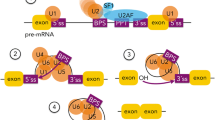Abstract
Alternative splicing is an important post-transcriptional regulatory mechanism that is implicated in development, tissue specific gene expression and disease processes, also in the heart. Splicing factors regulate this process. Next generation sequencing can be used to quantify genome wide alternative splicing and to elucidate the underlying mole — cular mechanism of factors such as RBM20, a key player in cardiac specific transcript processing.
Similar content being viewed by others
Literatur
Gerull B, Gramlich M, Atherton J et al. (2002) Mutations of TTN, encoding the giant muscle filament titin, cause familial dilated cardiomyopathy. Nat Genet 30:201–204
Greaser ML, Warren CM, Esbona K et al. (2008) Mutation that dramatically alters rat titin isoform expression and cardiomyocyte passive tension. J Mol Cell Cardiol 44:983–991
Guo W, Schafer S, Greaser ML et al. (2012) RBM20, a gene for hereditary cardiomyopathy, regulates titin splicing. Nat Med 18:766–773
Brauch KM, Karst ML, Herron KJ et al. (2009) Mutations in ribonucleic acid binding protein gene cause familial dilated cardiomyopathy. J Am Coll Cardiol 54:930–941
Li D, Morales A, Gonzales-Quintana J et al. (2010) Identification of novel mutations in RBM20 in patients with dilated cardiomyopathy. Clin Transl Sci 3:90–97
Trapnell C, Pachter L, Salzberg SL (2009) TopHat: discovering splice junctions with RNA-Seq. Bioinformatics 25:1105–1111
Wang ET, Sandberg R, Luo S et al. (2008) Alternative isoform regulation in human tissue transcriptomes. Nature 456:470–476
Anders S, Reyes A, Huber W (2012) Detecting differential usage of exons from RNA-seq data. Genome Res 22:2008–2017
Hafner M, Landthaler M, Burger L et al. (2010) Transcriptome-wide identification of RNA-binding protein and microRNA target sites by PAR-CLIP. Cell 141:129–141
Licatalosi DD, Mele A, Fak JJ et al. (2008) HITS-CLIP yields genome-wide insights into brain alternative RNA processing. Nature 456:464–469
Yeo GW, Coufal NG, Liang TY et al. (2009) An RNA code for the FOX2 splicing regulator revealed by mapping RNA-protein interactions in stem cells. Nat Struct Mol Biol 16:130–137
König J, Zarnack K, Rot G et al. (2010) iCLIP reveals the function of hnRNP particles in splicing at individual nucleotide resolution. Nat Struct Mol Biol 17:909–915
Maatz H, Jens M, Liss M et al. (2014) RNA-binding protein RBM20 represses splicing to orchestrate cardiac premRNA processing. J Clin Invest 124:3419–3430
Author information
Authors and Affiliations
Corresponding author
Rights and permissions
About this article
Cite this article
Maatz, H., Heinig, M. & Hübner, N. Alternatives Spleißen im Herzen. Biospektrum 21, 53–56 (2015). https://doi.org/10.1007/s12268-015-0539-1
Published:
Issue Date:
DOI: https://doi.org/10.1007/s12268-015-0539-1




